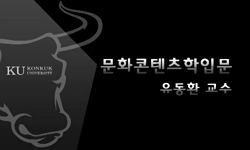In the 1990s, the term “cultural contents” has appeared and rapidly spread and grew, but it still suffers from academic difficulties. In particular, there are a number of problems in relation to other existing acdemic disciplines. The academic res...
http://chineseinput.net/에서 pinyin(병음)방식으로 중국어를 변환할 수 있습니다.
변환된 중국어를 복사하여 사용하시면 됩니다.
- 中文 을 입력하시려면 zhongwen을 입력하시고 space를누르시면됩니다.
- 北京 을 입력하시려면 beijing을 입력하시고 space를 누르시면 됩니다.
문화콘텐츠학과 기존 학문분류체계의 충돌과 공존 가능성 = Research on the Co-existence and Conflict between the Culture Contents Studies and the Conventional Academic Classification
한글로보기https://www.riss.kr/link?id=A106956129
- 저자
- 발행기관
- 학술지명
- 권호사항
-
발행연도
2020
-
작성언어
-
- 주제어
-
KDC
0
-
자료형태
학술저널
-
수록면
1-21(21쪽)
- 제공처
-
0
상세조회 -
0
다운로드
부가정보
다국어 초록 (Multilingual Abstract)
The academic research subject of cultural contents studies that has been considered so far is as broad as the meaning of the word 'culture'. It is not an exaggeration to say that if you put together the research purpose and the academic background suggested by the researchers, you are in charge of almost all academic fields. This forms another point where cultural contents studies collide with existing disciplines in the process of academic establishment. Although “interdisciplinary research” and “composite studies” have been suggested as the identity of cultural contents, this also does not appear to be a sufficient solution.
In the aspect of academic identity, the point where cultural contents studies collide with the existing academic system is as follows: (1) Several existing divisions that share the subjects and methods of cultural contents studies are already academically very strong. (2) Current cultural contents studies find it difficult to look out for a place to stably enter an existing academic system aimed at classifying according to differences. (3) Since the current cultural contents studies is related to most of the existing academic systems, it is difficult to narrow it down to a certain area and enter the academic discipline. In sum, the nature of cultural contents is difficult to match with the current academic system that has historically accumulated and reflected the current classification and systematization in a certain way. And there is no choice but to continue to collide.
As a clue to overcoming this conflict, three methods can be considered. First, the modern hierarchical linear academic classification system is reconstructed in three dimensions. Second, it is possible to find a breakthrough in cultural contents studies by setting new research areas and directions. Third, it is possible to consider ways to artificially narrow research problems and directions by accepting the conditions required by the current academic system and independent academic disciplines as realistic limitations or problems.
In the 1990s, the term “cultural contents” has appeared and rapidly spread and grew, but it still suffers from academic difficulties. In particular, there are a number of problems in relation to other existing acdemic disciplines.
The academic research subject of cultural contents studies that has been considered so far is as broad as the meaning of the word 'culture'. It is not an exaggeration to say that if you put together the research purpose and the academic background suggested by the researchers, you are in charge of almost all academic fields. This forms another point where cultural contents studies collide with existing disciplines in the process of academic establishment. Although “interdisciplinary research” and “composite studies” have been suggested as the identity of cultural contents, this also does not appear to be a sufficient solution.
In the aspect of academic identity, the point where cultural contents studies collide with the existing academic system is as follows: (1) Several existing divisions that share the subjects and methods of cultural contents studies are already academically very strong. (2) Current cultural contents studies find it difficult to look out for a place to stably enter an existing academic system aimed at classifying according to differences. (3) Since the current cultural contents studies is related to most of the existing academic systems, it is difficult to narrow it down to a certain area and enter the academic discipline. In sum, the nature of cultural contents is difficult to match with the current academic system that has historically accumulated and reflected the current classification and systematization in a certain way. And there is no choice but to continue to collide.
As a clue to overcoming this conflict, three methods can be considered. First, the modern hierarchical linear academic classification system is reconstructed in three dimensions. Second, it is possible to find a breakthrough in cultural contents studies by setting new research areas and directions. Third, it is possible to consider ways to artificially narrow research problems and directions by accepting the conditions required by the current academic system and independent academic disciplines as realistic limitations or problems.
동일학술지(권/호) 다른 논문
-
미디어 발달에 따른 문화충돌과 과거를 활용한 콘텐츠 향유의 공존 가능성 모색
- 콘텐츠문화학회
- 노창현 ( Noh Chang Hyun )
- 2020
-
4차 산업혁명시대의 문화콘텐츠의 가치 : 유교를 중심으로
- 콘텐츠문화학회
- 전성건 ( Jeon Sung Kun )
- 2020
-
정부와 지방자치단체의 지역소멸대응 관련 정책보고서 검토
- 콘텐츠문화학회
- 김진형 ( Kim Jin-hyung )
- 2020





 KISS
KISS



